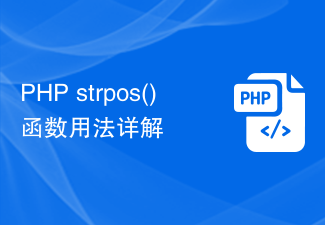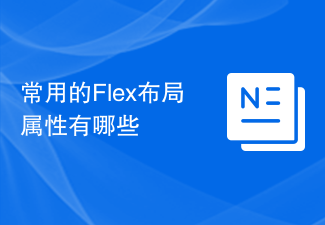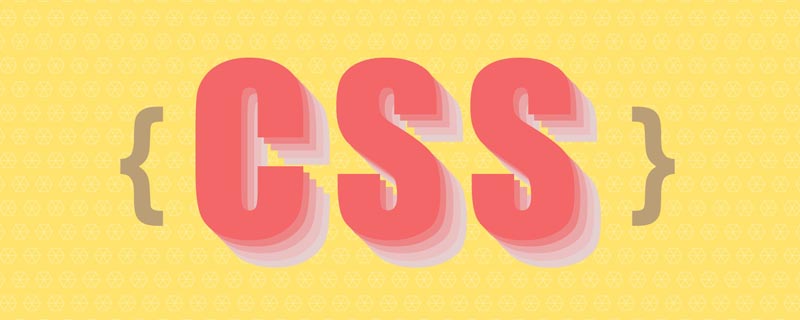This time I will bring you a detailed explanation of flex layout. What are the precautions of the detailed explanation of flex layout? The following is a practical case, let’s take a look.
Vertical centering is a common page layout method. For inline elements, you can set text-align:center;vertical-align:center to achieve,
Block-level elements can usually be achieved through the following settings
.parent{ position: relative;
}.child{ position: absolute; top: 50%; left: 50%; transform: translate(-50%,-50%);
} However, for the simplicity and elegance of css, in addition to inline, inline-block, and block layout, the fourth layout method of css, flex, came into being
Only The following settings are required to easily center the element vertically
.parent{ display: flex; justify-content: center; align-items: center;
}Note: When set to flex layout, the float, clear and vertical-align attributes of the child elements will be invalid
flexBasic concepts
Elements that adopt flex layout are called flex containers. All child elements within an element are called flex items.
The container has two axes by default: the horizontal main axis (main axis) and the vertical cross axis (cross axis).
The starting position of the main axis (the intersection with the border) is called main start, and the ending position is called main end; the starting position of the cross axis is called cross start, and the ending position is called cross end.
Items are arranged along the main axis by default. The main axis space occupied by a single item is called main size, and the cross axis space occupied by a single item is called cross size.
Properties of flex container
flex-direction flex-wrap flex-flow justify-content align-items align-content flex-direction
The flex-direction property determines the direction of the main axis.
row (default value): The main axis is horizontal and the starting point is on the left
row-reverse: The main axis is horizontal and the starting point is on the right
column: The main axis is vertical , the starting point is on the upper edge
column-reverse: the main axis is vertical, the starting point is on the lower edge
flex-wrap
By default, the items are arranged on the main axis, The flex-wrap attribute defines how to wrap a line if the main axis line cannot fit.
nowrap (default value):, do not wrap
wrap: wrap, the first line is at the top
wrap-reverse: wrap, the first line is at the bottom
flex-flow
The flex-flow property is the abbreviation of the flex-direction property and the flex-wrap property.
The default value is row nowrap.
justify-content
The justify-content property defines the alignment of the item (from the element) on the main axis.
flex-start (default): left-aligned
flex-end: right-aligned
center: centered
space-between: aligned at both ends , the intervals between items are all equal.
space-around: Each item is equally spaced on both sides. Therefore, the space between items is twice as large as the space between items and the border.
align-items
The align-items property defines how items are aligned on the cross axis.
stretch (default value): If the item does not set a height or is set to auto, it will occupy the entire height of the container.
flex-start: Align the starting point of the cross axis.
flex-end: The end point alignment of the cross axis.
center: Align the midpoint of the cross axis.
baseline: The baseline alignment of the first line of text of the item.
align-content
The align-content property defines the alignment of multiple axes. This property has no effect if the project has only one axis.
stretch (default value): The axis occupies the entire cross axis.
flex-start: Align with the starting point of the cross axis.
flex-end: Aligned with the end point of the cross axis.
center: Aligned with the midpoint of the cross axis.
space-between: Align with both ends of the cross axis, and the intervals between the axes are evenly distributed.
space-around: Each axis is equally spaced on both sides. Therefore, the distance between the axes is twice as large as the distance between the axes and the frame.
flex item (self-element) attribute
order flex-grow flex-shrink flex-basis flex align-self order
order attribute defines the order in which items are arranged. The smaller the value, the higher the ranking. The default is 0.
flex-grow
The flex-grow attribute defines the enlargement ratio of the item. The default is 0, that is, if there is remaining space, it will not be enlarged.
If all items have a flex-grow property of 1, they will equally divide the remaining space.
If the flex-grow property of one item is 2 and the other items are 1, the former will occupy twice as much remaining space as the other items.
flex-shrink
The flex-shrink property defines the shrinkage ratio of the item. The default is 1, that is, if there is insufficient space, the item will shrink.
If the flex-shrink property of all items is 1, when there is insufficient space, they will all be reduced proportionally.
If the flex-shrink attribute of one item is 0 and the other items are 1, the former will not shrink when there is insufficient space.
Negative values are not valid for this attribute.
flex-basis
The flex-basis property defines the main size of the item before allocating excess space.
Based on this attribute, the browser calculates whether there is extra space on the main axis. Its default value is auto, which is the original size of the project.
It can be set to the same value as the width or height attribute (such as 350px), then the item will occupy a fixed space.
flex
The flex property is the abbreviation of flex-grow, flex-shrink and flex-basis. The default value is: 0 1 auto. The last two properties are optional.
This attribute has two shortcut values: auto (1 1 auto) and none (0 0 auto).
align-self
The align-self attribute allows a single item to be aligned differently from other items and can override the align-items attribute.
Default value: auto, which means inheriting the align-items attribute of the parent element. If there is no parent element, it is equivalent to stretch.
This attribute may take 6 values. Except for auto, the others are exactly the same as the align-items attribute.
I believe you have mastered the method after reading the case in this article. For more exciting information, please pay attention to other related articles on the php Chinese website!
Recommended reading:
Observer Pattern of Javascript
Strategy Pattern of Javascript
The above is the detailed content of Detailed explanation of flex layout. For more information, please follow other related articles on the PHP Chinese website!
 Django框架中的缓存机制详解Jun 18, 2023 pm 01:14 PM
Django框架中的缓存机制详解Jun 18, 2023 pm 01:14 PM在Web应用程序中,缓存通常是用来优化性能的重要手段。Django作为一款著名的Web框架,自然也提供了完善的缓存机制来帮助开发者进一步提高应用程序的性能。本文将对Django框架中的缓存机制进行详解,包括缓存的使用场景、建议的缓存策略、缓存的实现方式和使用方法等方面。希望对Django开发者或对缓存机制感兴趣的读者有所帮助。一、缓存的使用场景缓存的使用场景
 PHP function_exists()函数用法详解Jun 27, 2023 am 10:32 AM
PHP function_exists()函数用法详解Jun 27, 2023 am 10:32 AM在PHP开发中,有时我们需要判断某个函数是否可用,这时我们便可以使用function_exists()函数。本文将详细介绍function_exists()函数的用法。一、什么是function_exists()函数?function_exists()函数是PHP自带的一个内置函数,用于判断某个函数是否被定义。该函数返回一个布尔值,如果函数存在返回True,
 PHP strpos()函数用法详解Jun 27, 2023 am 10:43 AM
PHP strpos()函数用法详解Jun 27, 2023 am 10:43 AMPHPstrpos()函数用法详解在PHP编程中,字符串处理是非常重要的一部分。PHP通过提供一些内置函数来实现字符串处理。其中,strpos()函数就是PHP中最常用的一个字符串函数之一。该函数的目的是在一个指定的字符串中搜索另一个指定字符串的位置,如果包含则返回这个位置,否则返回false。本文将通过详细分析PHPstrpos()函数的用法,助你更好
 常用的Flex布局属性有哪些Feb 25, 2024 am 10:42 AM
常用的Flex布局属性有哪些Feb 25, 2024 am 10:42 AMflex布局的常用属性有哪些,需要具体代码示例Flex布局是一种用于设计响应式网页布局的强大工具。它通过使用一组灵活的属性,可以轻松控制网页中元素的排列方式和尺寸。在本文中,我将介绍Flex布局的常用属性,并提供具体的代码示例。display:设置元素的显示方式为Flex。.container{display:flex;}flex-directi
 Gin框架的模板渲染功能详解Jun 22, 2023 pm 10:37 PM
Gin框架的模板渲染功能详解Jun 22, 2023 pm 10:37 PMGin框架是目前非常流行的Go语言Web框架之一。作为一个轻量级的框架,Gin提供了丰富的功能和灵活的架构,使得它在Web开发领域中备受欢迎。其中一个特别重要的功能是模板渲染。在本文中,我们将介绍Gin框架的模板渲染功能,并深入了解它的实现原理。一、Gin框架的模板渲染功能Gin框架使用了多种模板渲染引擎来构建Web应用程序。目前,它支持以下几种模板引擎:
 手把手带你使用CSS Flex和Grid布局实现3D骰子(附代码)Sep 23, 2022 am 09:58 AM
手把手带你使用CSS Flex和Grid布局实现3D骰子(附代码)Sep 23, 2022 am 09:58 AM在前端面试中,经常会问到如何使用 CSS 实现骰子/麻将布局。下面本篇文章给大家介绍一下用CSS 创建一个 3D 骰子(Flex和Grid布局实现3D骰子)的方法,希望对大家有所帮助!
 PHP中的ORM框架使用详解Jun 23, 2023 am 11:22 AM
PHP中的ORM框架使用详解Jun 23, 2023 am 11:22 AMORM(Object-RelationalMapping)框架是一种用于将面向对象编程语言中的对象模型与关系型数据库之间映射的技术。它使开发人员能够使用面向对象的方式操作数据库,而不需要直接操作SQL语言。在PHP开发领域中,ORM框架也得到了广泛的应用。本文将详细介绍PHP中的ORM框架使用方法。一、ORM框架的优点使用ORM框架有以下优点:1.提高开发
 Python中的GUI库wxPython详解Jun 09, 2023 pm 10:00 PM
Python中的GUI库wxPython详解Jun 09, 2023 pm 10:00 PMPython是一种简洁、易学、高效的编程语言。它广泛应用于各种领域,如数据科学、人工智能、游戏开发、网络编程等。虽然Python自带有一些GUI库,但他们的功能较为简单,无法满足各类复杂应用的需求。因此,Python中有许多GUI库可供选择,其中wxPython是其中一个,本文将详细介绍。wxPython简介wxPython是一个开源、跨平台的GUI库,它基


Hot AI Tools

Undresser.AI Undress
AI-powered app for creating realistic nude photos

AI Clothes Remover
Online AI tool for removing clothes from photos.

Undress AI Tool
Undress images for free

Clothoff.io
AI clothes remover

AI Hentai Generator
Generate AI Hentai for free.

Hot Article

Hot Tools

Dreamweaver Mac version
Visual web development tools

MantisBT
Mantis is an easy-to-deploy web-based defect tracking tool designed to aid in product defect tracking. It requires PHP, MySQL and a web server. Check out our demo and hosting services.

Notepad++7.3.1
Easy-to-use and free code editor

SAP NetWeaver Server Adapter for Eclipse
Integrate Eclipse with SAP NetWeaver application server.

SublimeText3 Mac version
God-level code editing software (SublimeText3)






